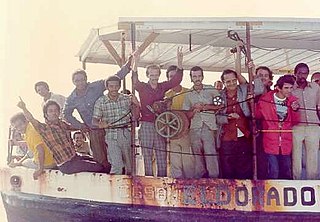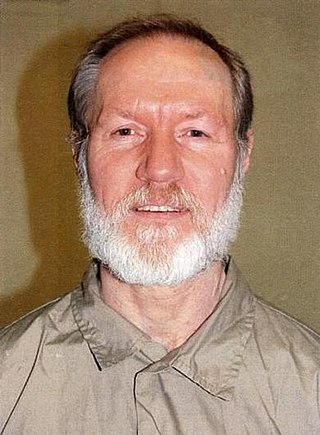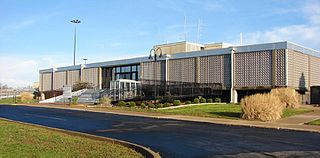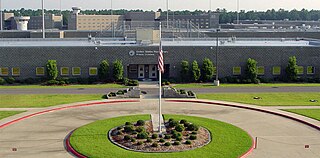Related Research Articles

The Mariel boatlift was a mass emigration of Cubans who traveled from Cuba's Mariel Harbor to the United States between April 15 and October 31, 1980. The term "Marielito" is used to refer to these refugees in both Spanish and English. While the exodus was triggered by a sharp downturn in the Cuban economy, it followed on the heels of generations of Cubans who had immigrated to the United States in the preceding decades.

The United States Penitentiary, Leavenworth is a medium security U.S. penitentiary in northeast Kansas. It is operated by the Federal Bureau of Prisons, a division of the United States Department of Justice. It also includes a satellite federal prison camp (FPC) for minimum-security male offenders.
Pedro Toledo Dávila was a former superintendent of the Puerto Rico Police. He served for two non-consecutive terms under two different administrations. Toledo was a former attorney and FBI agent.

The United States Penitentiary, Atwater is a high-security United States federal prison for male inmates in unincorporated Merced County, California. The institution also includes a minimum-security satellite camp. It is operated by the Federal Bureau of Prisons, a division of the United States Department of Justice.

Thomas Edward Silverstein was an American criminal who spent the last 42 years of his life in prison after being convicted of four separate murders while imprisoned for armed robbery, one of which was overturned. Silverstein spent the last 36 years of his life in solitary confinement for killing corrections officer Merle Clutts at the Marion Penitentiary in Illinois. Prison authorities described him as a brutal killer and a former leader of the Aryan Brotherhood prison gang. Silverstein maintained that the dehumanizing conditions inside the prison system contributed to the three murders he committed. He was held "in a specially designed cell" in what is called "Range 13" at ADX Florence federal penitentiary in Colorado. He was the longest-held prisoner in solitary confinement within the Bureau of Prisons at the time of his death. Correctional officers refused to talk to Silverstein out of respect for Clutts.

The United States Penitentiary, Atlanta is a low-security United States federal prison for male inmates in Atlanta, Georgia. It is operated by the Federal Bureau of Prisons, a division of the United States Department of Justice. The facility also has a detention center for pretrial and holdover inmates, and a satellite prison camp for minimum-security male inmates.

The United States Penitentiary, Marion is a large medium-security United States federal prison for male and female inmates in Southern Precinct, unincorporated Williamson County, Illinois. It is operated by the Federal Bureau of Prisons, a division of the United States Department of Justice. The facility also has an adjacent satellite prison camp that houses minimum security male offenders.

The United States Penitentiary, Lewisburg is a medium-security United States federal prison in Kelly Township, Pennsylvania for male inmates. It is operated by the Federal Bureau of Prisons, a division of the United States Department of Justice. An adjacent satellite prison camp houses minimum-security male offenders.
Special Operations Response Teams are a group under the US Federal Bureau of Prisons, or BOP for short, a component of the US Department of Justice (DOJ). The BOP is responsible for maintaining the custody of anyone convicted of committing a federal crime. To achieve this goal, the BOP maintains a number of correctional facilities, which are divided into six regions, throughout the US. These facilities house approximately 211,195 inmates of varying security levels. Facilities are designated as either minimum, medium, maximum, or the most recent addition, super max.
Weldon Lynn Kennedy was a special agent for the Federal Bureau of Investigation and served for 33 years. He is known for negotiating a peaceful end to the Atlanta Prison Riots and his involvement in the investigation of the Oklahoma City bombing. He retired as the FBI's No. 2 in command, Deputy Director, in February 1997.

The United States Penitentiary, Hazelton is a high-security United States federal prison for male inmates in West Virginia. The high-security facility has earned the nickname "Misery Mountain" by the inmates who are incarcerated there. It is operated by the Federal Bureau of Prisons, a division of the United States Department of Justice. The facility has a satellite prison camp for minimum-security male offenders.
Christopher Lawrence Jeburk is an American convicted felon who successfully committed a string of bank robberies along the East Coast of the United States. He escaped four times from prison, twice from a regional detention center and twice while in federal custody, to commit more crimes. He is currently incarcerated in a maximum security penitentiary USP Allenwood.

The United States Penitentiary, Pollock is a high-security United States federal prison for male inmates in unincorporated Grant Parish, Louisiana. It is part of the Pollock Federal Correctional Complex and operated by the Federal Bureau of Prisons, a division of the United States Department of Justice. The facility also has an adjacent satellite prison camp for minimum-security male offenders.
The D.C. Blacks is an African-American prison gang in the United States whose members are from Washington D.C. They are allied with the Black Guerrilla Family and some other black prison gangs. The Aryan Brotherhood is one of their main rivals. Although the D.C. Blacks are one of the largest prison gangs within penitentiaries, they are small compared to the gangs outside of the prison system, such as the Bloods and the Crips.

The United States Penitentiary, Beaumont is a high security United States federal prison for male inmates in unincorporated Jefferson County, Texas. It is part of the Federal Correctional Complex, Beaumont and is operated by the Federal Bureau of Prisons, a division of the United States Department of Justice.
The United States Penitentiary, Canaan is a high-security United States federal prison for male inmates in northeastern Pennsylvania, with a satellite prison camp for minimum-security male inmates. It is operated by the Federal Bureau of Prisons, a division of the United States Department of Justice.

The United States Penitentiary, Tucson is a high-security United States federal prison for male inmates in Arizona. It is part of the Tucson Federal Correctional Complex and is operated by the Federal Bureau of Prisons, a division of the United States Department of Justice. The facility also has a satellite prison camp for minimum-security male offenders.

The Federal Correctional Institution (FCI Talladega) is a medium-security United States federal prison for male inmates in Alabama. It is operated by the Federal Bureau of Prisons, a division of the United States Department of Justice. The facility also includes an adjacent minimum-security satellite camp that also houses male offenders.

The United States Penitentiary, Victorville is a high-security United States federal prison for male inmates in California. It is part of the Federal Correctional Complex, Victorville and is operated by the Federal Bureau of Prisons, a division of the United States Department of Justice.
Adams County Correctional Center (ACCC) is a medium security prison for men located in unincorporated Adams County, Mississippi, near Natchez, It is owned and operated by CoreCivic under contract with the U.S. Federal Bureau of Prisons. After striking ground in August 2007 at 20 Hobo Fork Road Adams Correctional Center opened July 2009.
References
- 1 2 Davis, Mark (November 22, 2012). "25 years later, Atlanta prison riots live on in captive's memory". The Atlanta Journal-Constitution. ISSN 1539-7459. Archived from the original on January 24, 2022. Retrieved August 6, 2023.
- 1 2 3 Pear, Robert (December 6, 1987). "Behind the Prison Riots: Precautions Not Taken". The New York Times. Archived from the original on January 20, 2017. Retrieved August 6, 2023.
- ↑ "NCJRS page on riots". Archived from the original on September 11, 2007. Retrieved May 22, 2007.
- ↑ Pear, Robert (November 26, 1987). "Military Hostage Specialists Sent to Help FBI at Atlanta Prison". The New York Times. Archived from the original on February 13, 2017. Retrieved August 6, 2023.
- ↑ Earley, Pete (1992). The Hot House: Life Inside Leavenworth Prison . New York: Bantam Books. pp. 121–123. ISBN 0-553-07573-X.